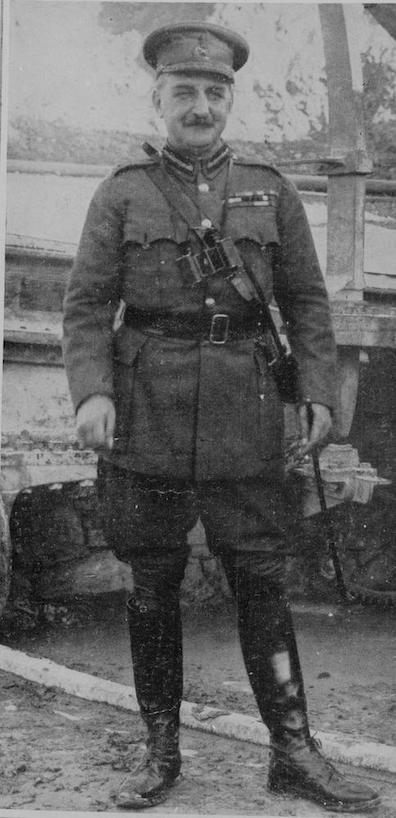As noted by Slote, Mamigonian, and Turner, Irish novelist
Colm Toíbín has observed that "Maxwell" might allude to
General Sir John Grenfell Maxwell (1859-1929), who was given
military command of Ireland during the Rising and instituted
tribunals resulting in summary judgments and hasty executions.
His position, combining high military rank with police
authority, would account for Joyce's description of him as "the
stern provostmarshal." A provost-marshal is a person in
charge of military police, and in fact Maxwell held precisely
this title in Egypt in 1884-85, when he served as a camp
commandant during the Gordon Relief Expedition. His service in
Egypt, Sudan, South Africa, and (starting in 1902) Ireland
amply defined him as a colonial governor, the sort of man that
Joyce could imagine having "blown a considerable number of
sepoys from the cannonmouth without flinching"––a
reference to the Sepoy Rebellion in India in the late 1850s.
As for "lieutenantcolonel," Maxwell was made a brevet
lieutenant colonel in 1888, a colonel in 1902, and later a
general officer.
Soon after the Easter Rising began the Lord Lieutenant of
Ireland declared martial law and the government in Westminster
appointed Maxwell to implement it. When he arrived in Dublin
on April 28 the principal rebels had already surrendered, but
he gave orders to "arrest all dangerous Sinn Feiners,"
including ones not actively involved in the rebellion. A wide
net was thrown, resulting in the detention of 3,430 men and 77
women. Trials began immediately at the Richmond
Barracks, many of them held in secret, without defense
attorneys or juries, and conducted by military officers who
had fought against the republican rebels––all violations of
longstanding legal and military procedure. Ninety people were
sentenced to death and 14 were executed by firing squad at the
Kilmainham Gaol in May before government officials became
concerned about the hasty and secretive sentences and put a
stop to the shootings. Maxwell left Ireland in 1916, never to
return. These facts richly confirm Toíbín's hunch and make
straightforward sense of Joyce's decision to call the overseer
of executions "Maxwell."
The name "ffrenchmullan" evokes another possible
historical model who was active on the other side of the
rebellion. Madeleine ffrench-Mullen (1880-1944) was an
advanced nationalist and labor activist, a member of the
radical women's organization Inghinidhe na hÉireann––and,
incidentally, a lesbian who lived with the same female partner
for 30 years. She served as a lieutenant in the Citizen's
Army, working in medical tents, and was one of the 77 women
imprisoned by Maxwell's forces. Her friend Hanna
Sheehy-Skeffington was married to one of Joyce's university
friends, Francis Sheehy-Skeffington, who enters Stephen
Hero, A Portrait of the Artist, and Ulysses as
MacCann or
McCann. Francis did not participate in the rebellion,
but British troops arrested him while he was trying to stop
rioters from looting and took him to the Portobello Barracks,
where he was executed without even a pretense of a trial. One
may assume that Joyce knew ffrench-Mullen, or at least knew of
her, through Skeffington and Sheehy. (Slote and his
collaborators mention her but suggest, without explanation,
that the name "is probably in jocular reference" to her father
St. Laurence ffrench-Mullen, who was not involved in the
Rising. Other than the obvious matter of gender, I cannot
imagine why they consider him a more plausible candidate than
her.)
Maxwell and ffrench-Mullen are jammed together in a kind of
chiastic sandwich between "Tomkin" and "Tomlinson." It seems
odd that Joyce would thus combine a colonial governor ordering
barely judicial killings with a republican activist threatened
with such killing. But the contradiction perhaps makes some
sense in context. The execution passage in Cyclops
makes wild comedy out of the brutal business of British state
executions, celebrating the victim as a hero while also
celebrating the entire affair as a diverting spectacle staged
for the entertainment of the public. (Executions around London
in the 18th century often had this festive quality; perhaps
some in Dublin did too.) The firing squads at the Kilmainham
Gaol did their grim work without any audiences, but by pulling
them into his allusive orbit Joyce manages to locate the 1916
Rising within a long tradition of violent rebellion and
violent repression that Ireland had not yet, at the time of
writing, seen the end of.

